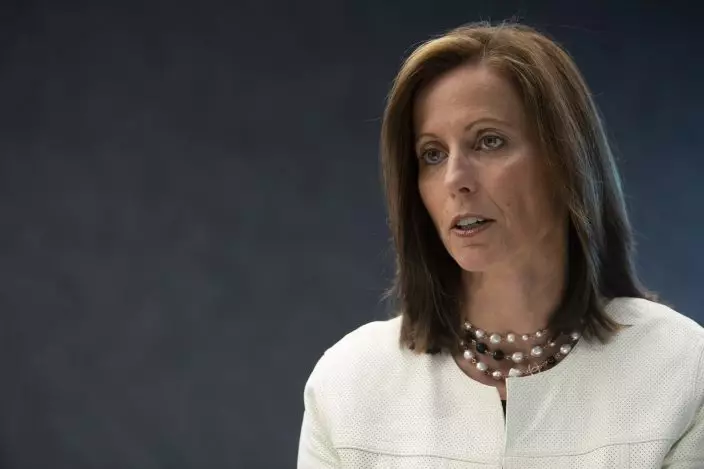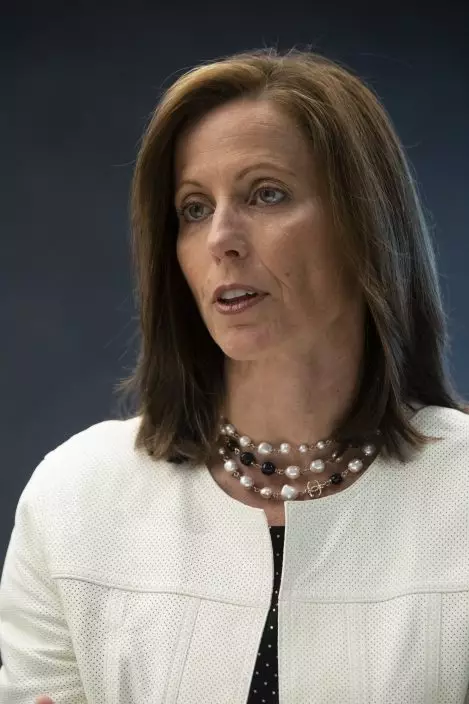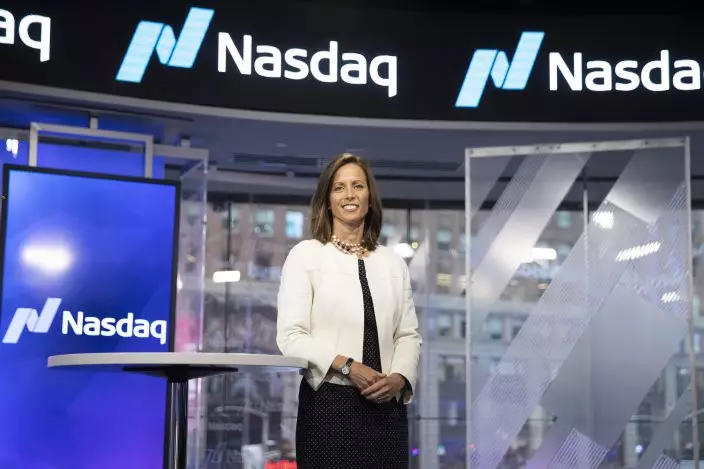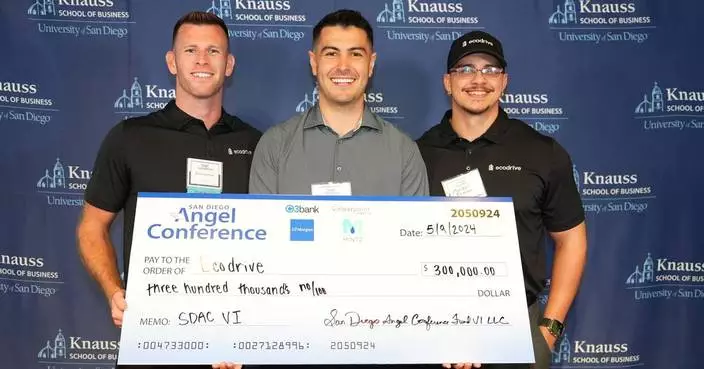The stock market is a much less crowded party than it used to be.
In the late 90s, when a bevy of hot dot-com companies were rushing to sell their shares on public markets, investors had more than 7,500 U.S. stocks to choose from. The dot-com bust culled many of those stocks, though, and the number has continued to shrink steadily, now down more than half from its 1998 peak.
That's doing a disservice to the typical investor, says Adena Friedman, chief executive officer of Nasdaq, who spoke recently with The Associated Press about how it can make income inequality worse. She also touched on how trading markets are striving to open up to the world, even as politicians push for more insularity. The conversation has been edited for clarity and length.

In this Wednesday, July 31, 2019, photo NASDAQ President and Chief Executive Officer Adena Friedman speaks during an interview at NASDAQ headquarters in New York. The U.S. stock market has thousands fewer companies to choose from, and that’s doing a disservice to regular investors, says Friedman. In a recent conversation with the AP, she discussed what’s behind the trend and how it could be exacerbating income inequality. (AP PhotoMary Altaffer)
Q: What's behind the shrinking number of stocks?
A: Companies are taking a lot longer and waiting to go public. A big part of the reason is that there are other sources of capital that they can use to drive growth in their companies. Private capital is just incredibly abundant and readily available, and there are early-stage investors who are willing to take a lot of risk to get into these growth companies.
So they have more choice. Then the rules of the government made it possible for them to have more shareholders as a private company than they used to. They weren't forced into the public market based on just having too many shareholders. They're going to wait until they feel like they're mature enough to handle the disclosure obligations and the scrutiny associated with going public.

In this Wednesday, July 31, 2019, photo NASDAQ President and Chief Executive Officer Adena Friedman speaks during an interview at NASDAQ headquarters in New York. The U.S. stock market has thousands fewer companies to choose from, and that’s doing a disservice to regular investors, says Friedman. In a recent conversation with the AP, she discussed what’s behind the trend and how it could be exacerbating income inequality. (AP PhotoMary Altaffer)
Q: And that's a bad thing?
A: The net result is that a lot of what I call average investors — people who are saving for their retirement, who are saving for their education or their kids' education — those investors don't get the chance to invest in those companies early in their life. They miss out on the growth and the opportunity that those companies provide.
And that, I think, is what we really have to pay a lot of attention to as a society: making it more attractive for companies to go public and making it so more investors have a chance to invest in that growth.

In this Wednesday, July 31, 2019, photo NASDAQ President and Chief Executive Officer Adena Friedman speaks during an interview at NASDAQ headquarters in New York. The U.S. stock market has thousands fewer companies to choose from, and that’s doing a disservice to regular investors, says Friedman. In a recent conversation with the AP, she discussed what’s behind the trend and how it could be exacerbating income inequality. (AP PhotoMary Altaffer)
We always say markets are the most democratic part of the capital market system — any person can come in and invest $100 and find a company that they really want to buy or an ETF or any sort of any investment, and they all have equal access to the markets. That's not the case for private companies. It's really reserved for the wealthier parts of society.
Q: Do all these recent high-profile IPOs, like Lyft's and Uber's, mean the trend is shifting?
A: We do have companies that are coming out and going public. We had 189 IPOs last year. We've had almost 100 IPOs this year. So we know that we're giving investors access to some great companies, but some of them — a lot of the bigger tech companies — are later in their life cycles. So they've already gone through a big growth wave before the public investors get a chance to invest in them.

In this Wednesday, July 31, 2019, photo NASDAQ President and Chief Executive Officer Adena Friedman speaks during an interview at NASDAQ headquarters in New York. The U.S. stock market has thousands fewer companies to choose from, and that’s doing a disservice to regular investors, says Friedman. In a recent conversation with the AP, she discussed what’s behind the trend and how it could be exacerbating income inequality. (AP PhotoMary Altaffer)
Q: A lot of IPOs recently have been for money-losing companies, and critics say it's reminiscent of the dot-com bubble. Is there such a thing as too many IPOs?
A: No.
Nasdaq was formed in 1971, and we founded our listings business on one premise: We wanted younger companies to be able to tap the public market. So before Nasdaq was created, you had to already be successful before you could actually get public investors to help grow your company. You had to be profitable, and you had to have a record of profitability, and that held back thousands of companies from being able to use the public markets to grow their companies so that they could become profitable.

In this Wednesday, July 31, 2019, photo NASDAQ President and Chief Executive Officer Adena Friedman poses for a photo at NASDAQ headquarters in New York. The U.S. stock market has thousands fewer companies to choose from, and that’s doing a disservice to regular investors, says Friedman. In a recent conversation with the AP, she discussed what’s behind the trend and how it could be exacerbating income inequality. (AP PhotoMary Altaffer)
I can name some really interesting companies — Intel, Applied Materials, Comcast and Paccar — those four companies went public in our first class of listings, and all of them are in the Nasdaq 100 today. They were not profitable companies, but they were building scalable profitable companies that were changing the world.
I believe that the public market should be for companies to discuss their story, back up their story with numbers and facts and figures, fully disclose the opportunities and the risks of the company and let investors decide: Do they have a scalable business model that will grow to profitability, or don't they?
Don't make it so that the company already has to have reached a certain point before a public investor even gets the chance to invest in it.
Q: The stock market is close to a record high, and this has been the longest running bull market on record. Does it feel to you now like it did at prior peaks, like 2007 before the Great Recession or 2000 before the dot-com bust?
A: I don't try to compare. I would say that when I look back on some of the true bubbles that existed, I would not say I feel like we're in that kind of environment.
I think people see these companies come out, and they can see a big total addressable market. They can see how these companies could grow and change an industry and maybe even change the world. And I think they see an optimistic view as to what the growth characteristics of the economy are. And they couple that with: What are my alternatives?
My alternatives are really low interest rate debt. Other asset classes just don't yield the same kind of return.
I would say there's more foundation behind what we're experiencing today than there was, certainly at the height of the internet bubble.
Q: Nasdaq is making a lot of investments in technology, and its technology is used in markets all over the world. Can you point to some of the more interesting examples?
A: Our technology today is used in 130 markets around the world. Our job is to allow other markets to create a fair and mature experience for their capital markets.
The Indonesia Stock Exchange uses our trading technology, our clearing technology and our surveillance technology. They're creating a good market for foreign investors to come in, and it allows them to focus on educating their local citizens on how to become investors.
But our technology is also applicable outside the capital markets. We have technology that is used to support certain sports betting. We have a platform that's used by the Hong Kong Jockey Club, it's used by the Australian racing authority and we're deploying it into Sweden as well. We know how to run complex auctions, so our technology can be used there as well.
Q: If you go back to the Indonesia example, how concerned are you that the growing insularity around the world — populism and nationalism and drawing within — is running counter to all that you said?
A: I think capital markets are, by nature, global. And the more of a common experience you can create across the world, the more investors will come into the markets. And at the end of the day, what does the country really want? They want investment in their country. They want to grow their economy. They want to create jobs. They want to give entrepreneurs an opportunity to grow a business, and they want their GDP to grow because it will increase opportunity for their citizens.
So I think it runs counter to the politics because at the end of the day, exchanges by nature are actually nationalistic, but using international standards to drive more investment into your country is for your benefit as a nation.
Q: What about foreign investors? Will they pull back?
A: I think that foreign investors are very data driven. If they see opportunity for a return in a responsible way in a country that they think is driving to growth, they want to be able to take advantage of that.












